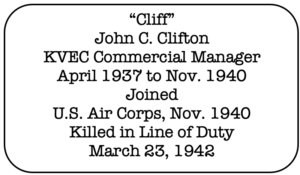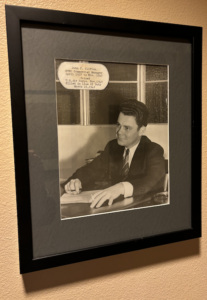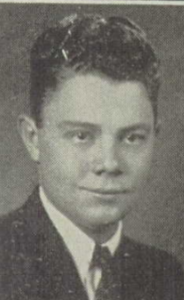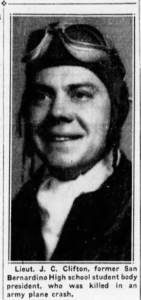Mountain View Cemetery, San Bernardino
The long hallway from the lobby to the KVEC radio studio on Sacramento Drive in San Luis Obispo is lined with memories, vintage black-and-white photos that trace the history of a station that first signed on in 1937.
To the left, second one down, is a photo of a young man, dressed smartly in a dark suit, sitting behind an office desk. A cigarette in his left hand, a pen in his right. His hair is dark and wavy, the smile somewhat forced, as if he’s not exactly comfortable having his picture taken.
The caption reads:

I have been passing this photo almost daily since KVEC moved to Zaca Lane in 2002. The station had been recently purchased by Clear Channel and a box of historic photos came with the deal.
 Management decided to celebrate our storied history by displaying the photos, though nobody ever bothered to correctly identify who was who in each picture. Clifton was the exception—somebody back in the day had taken the time to dutifully note his name, title, dates of employment, military service, and the sad reference to his death during World War II.
Management decided to celebrate our storied history by displaying the photos, though nobody ever bothered to correctly identify who was who in each picture. Clifton was the exception—somebody back in the day had taken the time to dutifully note his name, title, dates of employment, military service, and the sad reference to his death during World War II.
Sad is the operative word. I knew nothing about the man, except that he was obviously young and died in service to his country during a horrible war. You can’t walk by his photo that often without pausing to consider his sacrifice and What Might Have Been.
But other than those brief 27 words in a faded caption, I knew nothing about John C. Clifton.
Then along came Jim Gregory.
Jim is a retired high school history teacher, author of five books, and president of the South County Historical Society. He is passionate about local history, blessed with a basset hound-sized curiosity, spending his free time sniffing around in the past.
That one picture on the wall was enough to pique Jim’s interest.”
During a recent radio visit, I mentioned the story of John C. Clifton to Jim and showed him the photo in the hallway as he was leaving. That one picture on the wall was enough to pique Jim’s interest.
By the end of the week, Jim shared with me bits and pieces of Clifton’s life that he had been able to piece together from online research. Hardly enough for a memoir, but enough to flesh out the young man’s story a bit. His character. His potential.

John Campbell Clifton was born on June 5, 1916 in Greenville, Texas. The 1930 Census lists him living in California, where he graduated from San Bernardino High School, Class of ’34. He was student body president. And valedictorian.
Those accomplishments were enough to earn Clifton a spot at Stanford, where he spent the next two years, drawing attention as a tennis star. He dropped out of college to pursue radio engineering, a decision that brought him to San Luis Obispo when KVEC owner Christine Jacobson hired him in April, 1937.
Clifton, now all of 21, apparently impressed Jacobson, because he was made acting station manager one month before KVEC began broadcasting.
The former student body president took up the challenge and kept the job for the next three years, a lifetime for some in the topsy-turvy turnover world of broadcast management.
Clifton appears to have made a favorable community impression. The San Luis Obispo Tribune of July 12, 1937 reported on a presentation the young station manager gave to the local Rotary Club.
“Rotary Club members heard John Clifton, acting manager of station KVEC, tell of the operation of a radio transmitting system…Mr. Clifton explained in an interesting way the technical work of conducting a radio station with the problems that confront it.”
Thanks to Jim, John C. Clifton is now more than simply a face in the photograph on the wall . . .”
The SLO life for Clifton in 1938 meant sharing a house on Palm Street with three other men. He joined the San Luis Obispo Amateur Tennis Club where he became an avid competitive player. Paul Haupert of Santa Barbara beat him in a match in July of that year, according to press reports, but Clifton made him earn it: 7-5, 3-6, 6-3.
By 1940, the winds of war were stirring and Clifton sought a new challenge. He resigned from KVEC and enlisted in the U.S. Army Aviation Corp. some 13 months before Pearl Harbor. Basic training in his native Texas, then advanced flying school in Louisiana. Lt. John C. Clifton, always in a leadership role, was ready for duty.

But Clifton would see no overseas action; instead, his mission became training those pilots who would—first at Barksdale Field in Louisiana, before transferring to Kaye Field in Mississippi in January of 1942.
He would be dead two months later.
On the evening of March 23, 1942, Clifton was on a routine evening training flight with a student pilot, Harold K. Persinger of Muncie, Indiana, at the controls.
Something went terribly wrong and the plane, a Cessna AT-8 Bobcat, crashed about two miles from the airfield, killing both men instantly.
According to Jim Gregory, flight training was as deadly as combat during that era. Half the San Luis Obispo County airmen lost in World War II died in accidents.
“We’ll never know why the plane went in,” Jim says. “But the sparse record doesn’t indicate engine failure, which would’ve been duly recorded. Night flying can be very dangerous, even for experienced pilots like Lt. Clifton.”
Clifton’s body was brought home to San Bernardino and buried in a family cemetery plot, roughly two months shy of his 26th birthday: one of 405,399 American soldiers to perish during the war.
Student body president. Valedictorian. Tennis champ. Radio station manager. Army lieutenant. Flight training officer. A young man who flew high and fast, flaming out well before his time.
Thanks to Jim, John C. Clifton is now more than simply a face in the photograph on the wall that I pass by daily. Though, in truth, the more I learn about the guy, the deeper the sense of loss.
Jim agrees. “What struck me as I researched Clifton was that this was a gifted and extraordinary young man,” he told me. “Losing him cheated all of us.”
